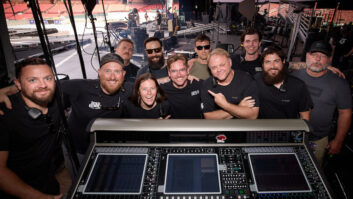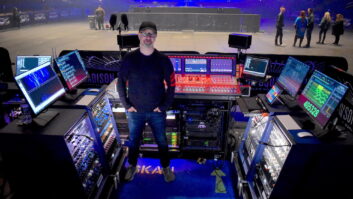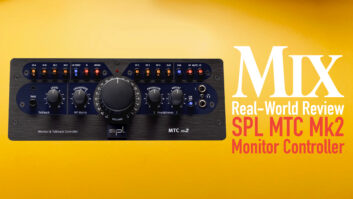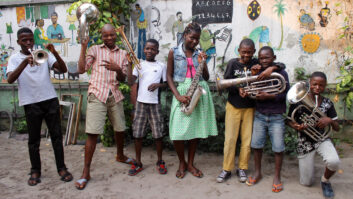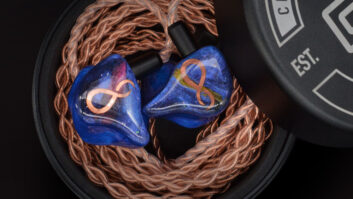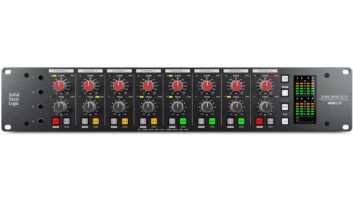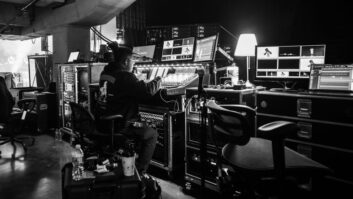It’s been nearly forty years since Springsteen’s debut Greetings From Asbury Park, NJ, and judging from the 3-hour-plus shows, sold-out arenas, and glowing critical reviews, both rocker and band [minus the late, beloved saxophonist Clarence Clemons and keyboardist Danny Federici] are still regaling in their ‘Glory Days.’ With the Wrecking Ball Tour, in support of their 17th studio album, Springsteen & Co are heading into a two-month U.S. fall stadium tour following a massive world tour that started in March of 2012 taking them around the globe. Solotech US Corp. is the tour’s production provider.
Critical monitor mixes for the 18-piece band are split in two between engineers Monty Carlo and Troy Milner and for the first time ever they’re employing a pair of DiGiCo SD7s outfitted with the Waves SoundGrid bundle. At stage left is Carlo, who’s been with Springsteen since ’92, handling a mix of wedges and in-ears for Bruce, guitarists Steven Van Zandt and Patti Scialfa, keyboardist Roy Bittan, background vocalists, and a five-piece horn section. Milner, onboard since 2001, is at stage right taking care of drummer Max Weinberg, guitarist Nils Lofgren, bassist Garry Talent, keyboardist Charlie Giordano and multi-instrumentalist, Soozie Tyrell.
The engineers specifically chose the SD7 for its flexibility and ability to grow with the size of the production, including the massive amounts of I/O capabilities that it offered. Onboard features from snapshots to multiband compressors and the Waves pro plug-in bundle offered lots of extra functionality.
“From 2002-2009 we used Yamaha PM1D’s for monitors,” Carlo explains. “Since then, our band has grown from 9 musicians to 18 on this tour with the occasional guest on top of that. We needed something that could handle a large number of inputs, (over 100), and a massive amount of outputs, about 56 on each side of the stage. The DiGiCo SD7 was the only console I found that could accomplish what I was going to ask of it. Before this tour, I’d never actually mixed on a DiGiCo of any variety. I spent some time in the past year building the console with the Offline Editor and getting familiar with its layout and feature set. In November 2011, I got together with Troy in Nashville and we spent a couple of days with Matt Larson getting a hands-on training session with the desk. Following that, we spent the first 3 months of 2012 in rehearsals and doing some small promo events (Grammy’s, Jimmy Fallon and SXSW Festival). With the addition of a horn section and percussionist a lot of songs ended up with slightly different arrangements and we spent a fair amount if time working through the new album since not many of the band members had worked on it in its entirety.”
“We needed consoles that could handle a lot of inputs and outputs and be flexible,” adds Milner. “Before rehearsals began, we still didn’t have a concrete plan for what was going to be needed as far as band members and layouts. Things were constantly changing even into the first run of shows. I used the SD7 last year with Garth Brooks—and the D5 on numerous tours with Michael W. Smith, Mercy Me, and Amy Grant—and it performed perfectly.”
With approximately 96 inputs alone coming from the stage, plus effects and talkbacks, Carlo is managing about 112 inputs total from stage left. Being able to mix mono and stereo sources on the same fader bank as I want to see them on the desk is a huge deal for him. “I love not losing two faders to a stereo input or output as used to happen on the 1D. The level you can customize the surface is so flexible and easy to change that as your input list and band grows you aren’t stuck simply adding channels at the end of the console. Being able to rebuild the desk in a way that better suits your workflow in mid-tour is a great luxury. Plus, the multiband compressors on each channel are a great tool that I’ve been using more than I thought I would.”
Carlo’s got his favorite Waves plug-ins. “On my in-ear mixes I use the C-6 compressor and Kramer PIE compressor across the mixes. I’m using the H-EQ as an insert on Bruce’s vocal channel to allow me to get a few additional bands of EQ that I can use for tight notches on troublesome frequencies. For effects I’m using H-Delay, TrueVerb and Renaissance Verb. I’m also using GTR Stomp and Amp plug-ins on Bruce’s guitar lines in case of a problem with his amps/cabinets on stage.”
Over at stage right, Milner mixes a staggering 140 inputs, comprised of a fair amount of effects for drums and guitars, in addition to a combo of wedges and in-ear systems, including Shure PSM1000’s for ears and a mix of Audio Analysts wedges consisting of SLP115, SLP212, plus a couple of double Audio Analysts 18″ sub cabinets for drum subs.
“I double assign the drum inputs so I can tailor them for the drummer independently from everyone else. Again, another great super easy feature on the SD7. One of the biggest challenges on this tour is just the large amount of inputs and outputs we have to deal with up onstage. We have settled in now but we still have plenty of options to easily add, change or move things around without reinventing the wheel. We also have a great Talk Back system for all the techs and backline guys that are in our ears at all times, so we can be attending to issues before anyone is even aware what is happening.”
Milner’s found a plethora of onboard features and functionality helpful in his day-to-day workflow. “Being able to assign the rotary knobs on each bank to a specific function is very handy. I’m using one row for Compressor Thresholds and on my drum input bank I use one row at my Gate Threshold. Max Weinberg is a very dynamic player and I’m constantly adjusting those gates for each song and throughout each song to keep things under control for him. Also, having the ability to move any fader to any place on the desk is so great. After mixing a few shows, I learned that just moving a few inputs to other banks and reordering my outputs could vastly improve my current layout. Such a great feature! I’m also finding all kinds of new things to use the Macro Keys for now. One is that between songs when the stage is dark, it can be a little hard to see the band onstage, so I have macro key that dims all the lights and monitors down so its easier to see what they might need. Also, using a Macro Key to switch the extra video monitor inputs. I’m getting a full production feed as well as other feeds and I can just use a macro to select the one I need for any given song.”
“For most of my reverbs I’m using the Renaissance Reverb and it sounds great in every application—from drums to background vocals to horns. I’m also using the SuperTap for some delay/slap effects on the drums and horns. The Waves C6 is one of my go-to plug-ins for just about anything, and I’m using it on the snare and toms to shape the sound in the ears and also on some vocals. The CLA-76 Bluey is another favorite, and the list goes on and on. It’s great to be able to easily try out all these fantastic plug-ins on inputs and or outputs to see what works for each application.”
One of the biggest challenges with the Springsteen show is the set list, which they receive literally 5 minutes prior to the start of the show. Not only does it change from night to night, but also during the show, Bruce can veer off the list at a moment’s notice. The snapshot feature has become invaluable for both engineers.
“With the PM1D, I had a sheet with all my scenes that I would have to jump around during the show,” Carlo recalls. “With the SD7’s snapshot panel, I can order the list as Bruce intends to do the show, but then when he decides to jump to something off the list, it’s as easy to get to as typing the first letter of the song until I get to the desired snapshot. Right now, I’m at around 130 snapshots.”
“We never know what Bruce will do next or what song he will pull out, so being able to load those snapshots quickly is a challenge,” adds Milner. “I use the keyboard and just type the first letter of the song and it will jump through all those snapshots starting with that letter. Then you can fire the snapshot with the space bar very quickly. This is usually not a problem on other tours but with over 150 snapshots it can take time to go through them all. I have an external monitor hooked on the ‘B’ engine so with everything mirrored to the ‘A’ engine I can make sure I’m running in complete redundancy at all times.”
For both engineers, the SD7 has proved to be a reliable and accommodating asset for this complex and unpredictable production.
Carlo says he’s found the SD7 to be one of the most flexible consoles out there. “I can configure it to look and operate exactly the way I need it to depending on what type of show/band I’m going to be mixing on it. It sounds great, it’s warm and full without any brittle or sterile characteristics that other consoles sometimes have. Looking ahead, and depending on the show, I might be inclined to try something a bit smaller than the SD7, however, the redundancy inherent in the SD7 with its dual engines and power supplies is a solid feature.”
Milner agrees. “Absolutely, I’ll be using DiGiCo again. They sound great and are so flexible to use especially with a large number of inputs and outputs and with all the different SD console options out now, it makes finding the right desk for each application simple. On this tour, the band seems to be really happy—and with 18 people on stage and all those open mics things can get messy really fast. We seem to have found a good balance for each band member and what works for them on any given song. The SD7 sounds great and is very neutral-sounding. It doesn’t seem to color the sound at all which is nice. You can start with the source and if that sounds good, then you know things will sound great with the console. I don’t know of any other desk out there right now that can do what we are asking of these consoles. With 140 inputs, 52 outputs and around 150 snapshots (and that number is always growing) we are making these desks earn their keep!”

